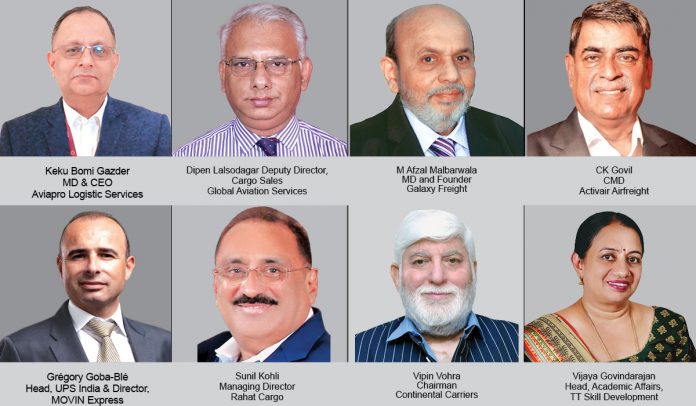Boosting exports is crucial for giving pace to economic growth and fortifying India’s position in global trade. By focusing on improving infra, enhancing logistics and streamlining trade policies, India can expand its export potential. Investments in technology, agriculture manufacturing and leveraging trade agreements can open new markets and increase competitiveness.
Ritika Arora Bhola
After recording double-digit growth in October 2024, India’s exports in November contracted 4.85 per cent YoY to US$ 32.11 billion, while the trade deficit widened to an all-time high of US$ 37.84 billion due to a record surge in gold imports.
According to the available data from late 2024 and early 2025, though India’s exports have grown, but the pace of growth has been uneven. India’s merchandise exports grew by around 2 to 3 per cent year-over-year in the recent months.
Slow global growth: The global economic slowdown, particularly in key markets such as the USA, Europe, and China, has affected demand for Indian exports. Trade tensions, inflationary pressures, and increasing interest rates in the developed economies have contributed to weaker demand for textiles, engineering products, and chemicals, among others, which are export categories for India.
Commodity prices: Fluctuations in commodity prices, especially crude oil and metals, influence the country’s export performance. When international prices of oil and other commodities are low, it reduces the overall value of the country’s exports, even if the volumes remain stable or increase.
IT & services exports: India’s exports of IT services, software, and business services, have continued to perform well, with consistent growth in this sector. The IT industry remains competitive globally, though there is demand for outsourcing and digital services.
Government initiatives: The government has introduced measures to boost exports, such as offering incentives for specific sectors (e.g., electronics, textiles, agriculture), improving trade logistics, and negotiating trade agreements with other countries. These efforts have contributed to export growth, particularly in non-traditional sectors such as electronics and agricultural products.
Exchange rate: A relatively weaker Indian Rupee against the US$ has also helped Indian exporters by making their goods competitively priced in international markets.
While Indian exports are growing in sectors, such as IT and agricultural products, overall export growth has been moderate in recent months. The challenges posed by slower global growth, reduced demand in some markets and volatility have slowed the pace of export expansion. However, government policies aimed at diversifying export markets and sectors offer the potential for long-term growth. According to industry projections, cargo volume is expected to grow by 8 to 10 per cent annually, driven by the rise in e-commerce and demand for high-value products. The sector faces challenges hindering its growth, such as high taxes on Air Turbine Fuel, which has impacted airline operating costs and profitability. The absence of India’s ratification of the Cape Town Convention complicates aircraft financing, leading to higher leasing rates. Also, the underdeveloped MRO capabilities result in outflows for component and engine maintenance abroad. Infrastructure and regulatory hurdles, limit the sector’s potential, demanding policy reforms and investments to sustain its rapid expansion.
Trade deficit
As per the data from December 2024 and early 2025, India is experiencing a trade deficit, although the situation has shown some improvement compared to earlier periods. The country’s trade deficit is a regular feature of its economic landscape, and policymakers monitor the situation closely to balance growth with external sector stability. Factors influencing India’s trade deficit, including the high import bill for crude oil, gold, among others, while exports have been impacted by global demand and supply chain conditions. The trade deficit has fluctuated over the past year, and the govt government has taken various steps to manage the deficit, such as promoting export growth and reducing reliance on imports for certain goods.
India’s export market is changing quickly. The machinery and electronics sectors are becoming critical. Sectors such as textiles, garments, gems and jewellery have declined sharply compared to export figures from 20 years ago. This change in results is due to shifting demand and the challenge of staying competitive in jobs that require a lot of labour. delves into depth and finds out from experts’ as to which commodities will drive growth in the coming years and boost exports.
Advanced forecasting to streamline logistics ops
Keku Bomi Gazder, MD & CEO, Aviapro Logistic Services
Strategies to boost exports include leveraging dedicated cargo flights and advanced forecasting techniques to optimise capacity and streamline logistics operations. Aerodynamic operations and reduction of processing time through adoption of digital platforms for booking, tracking, and documentation. Optimising costs possible through energy-efficient technologies, automation, and route planning. Enhancing MRO capabilities by developing aircraft maintenance, repair, and overhaul facilities to establish India as a global hub for aviation servicing. The sector is poised to boost exports in coming months.
Trade deficit & inflated US Dollar affect exports
Dipen Lalsodagar Deputy Director, Cargo Sales, Global Aviation Services
As per latest report, exports contracted 1 per cent in December due to low crude prices, but trade deficit narrowed down to a three-month low. Factors such as US Dollar appreciation, continued disruption in supply chain and potential trade tariffs, are affecting exports. Since the exports are on the decline, schemes such as incentivising specific commodities for a tenure, setting up value-based export targets with drawback scheme, are focusing on perishables & pharma to help boost exports. India will have huge air cargo capacity in coming decade with new aircraft in service.”
India must explore new markets to boost exports
M Afzal Malbarwala MD and Founder, Galaxy Freight
We are facing challenges such as Red Sea crisis, Russia-Ukraine war, and trade tensions involving the USA and China and Mexico. To address these, India must explore new markets and expand its products and services. India should close the gap between sectors such as electronics, textiles and gems and jewellery, by adjusting tariffs that hinder growth. Simplifying customs, improving business conditions, and encouraging innovation are vital to hike exports. The drivers of merchandise export growth include electronic and telecom products, drugs, pharma among others.”
Trade deficit due to weak USA & EU demand
CK Govil, CMD, Activair Airfreight
Export performance has shown mixed trends, with double-digit growth in October 2024 followed by a contraction of 4.85 per cent in November last, indicating a period of volatility. The underlying reasons for this contraction and the overall trade deficit include a slowdown in global demand due to geopolitical tensions, inflationary pressures, and reduced consumption in markets such as the USA and European Union (EU) which has affected exports. Exporters of sectors such as textiles, electronics, and agriculture, may face challenges in maintaining competitive pricing.”
Exports likely to surpass US$ 800 billion this year
Grégory Goba-Blé, Head, UPS India & Director, MOVIN Express
The country’s exports are likely to surpass US$ 800 billion this year, driven by high-growth sectors, including manufacturing, electronics, and pharmaceuticals. This expansion underscores the country’s economic landscape and its capacity to meet rising global demand for innovative products. Important drivers, including innovation in hi-tech machinery and healthcare, highlight the country’s growing significance in international trade. As India diversifies and expands its export portfolio, we are investing to help businesses strengthen their position in global markets.”
Incentives to boost high-value exports
Sunil Kohli, Managing Director, Rahat Cargo
To promote exports from India, the policies on vital segments are likely from the government; it should consider addressing the complexities in disbursement of funds under the PLI schemes apart from pacing up of incentivisation—helping boost towards high-value exports. The manufacturing capabilities should be strengthened on the domestic front. And India must focus on skilling its youth population such as the Skill India and Make in India mission. For boosting Indian exports, infra development is crucial with reduced logistical costs.”
Renegotiating FTAs to open new opportunities
Vipin Vohra, Chairman, Continental Carriers
To enhance exports, India must diversify markets, targeting emerging economies and non-traditional regions. Strengthening manufacturing under Make in India and improving quality standards are key. Renegotiating FTAs can open new opportunities. Promoting supply chain digitisation and reducing logistics costs through infra upgrades will improve efficiency. Incentives for value-added products, MSMEs support, and global branding initiatives will help India gain a competitive edge in global markets. Export drivers include electronics and electric vehicles, among others.”
Reforms to create skill development initiatives
Vijaya Govindarajan, Head, Academic Affairs, TT Skill Development
Despite recording double-digit growth in October 2024, exports contracted by 4.85 per cent in November due to global economic uncertainties and rising import costs, particularly gold. This calls for an approach to sustain growth and address structural challenges. AI and blockchain can enhance export performance. AI enables predictive analytics for demand forecasting, inventory optimisation, and supply chain transparency, reducing inefficiencies and improving global competitiveness. India’s logistics costs remain among the highest at 14 per cent of GDP. India also faces a shortage of skilled manpower.”















